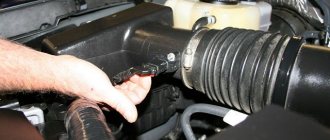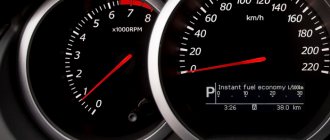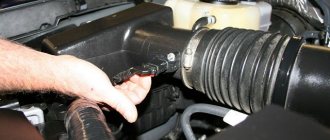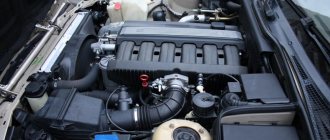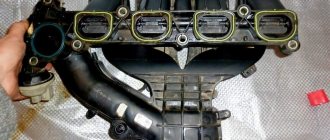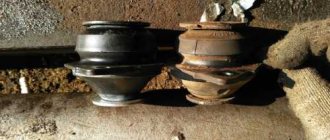In hot weather or just in the summer, the car drives simply amazing, but after a while the revolutions begin to drop, the car does not pull, the temperature is normal, I brake, stand for five minutes, rest, start it and drive normally. About 20-30 minutes, then everything repeats again, the check is not displayed. In cool weather in winter everything is fine, there is no such thing. Last year there was exactly the same malfunction, but then a check was displayed, and the malfunction came out on its own: the brushes on the starter were worn out. After replacement, I drove it and didn’t know any grief. But now I don’t know what to think, maybe you can tell me? Vladimir.
Hello, Vladimir. Symptoms such as those occurring in your car cannot indicate a specific breakdown. Here you need to look at the car to find out exactly why you are losing speed when driving.
We will give you some recommendations:
- First you need to check the operation of the fuel pump. Apparently, this is where the problem lies. When you experience symptoms of “sickness” again while moving, take a wet cloth and place it directly on it. If the idle speed levels out and the engine starts running well again, then it is most likely time to replace the fuel pump. In addition, we recommend that you check the pump screen, which is also considered a fuel filter. Clean it, as it is often the cause of unstable engine operation.
A clogged mesh (fuel filter) can also cause the car to lose power when driving.
- Re-diagnostics of the car. You may be having problems with your starter again. Or maybe the malfunction lies in incorrectly functioning sensors: throttle position, idle speed control, mass air flow, coolant temperature, crankshaft position. In total, incorrect operation of several devices can cause a loss of power when driving. In any case, if you have such problems, then diagnosis is the first thing to do.
- Often with such problems, the malfunction lies in incorrectly functioning ignition coils. Check their functionality.
- If the speed drops when the cooling fan turns on, then look for an electrical problem. In this case, the problem is directly related to the electrical circuit. There is a possibility that vehicle diagnostics will show you an insufficient voltage level in the on-board network at idle. Perhaps the problem lies in the incorrect operation of the thermostat, which is installed in the voltage regulator. If this is the case, then install a three-level voltage regulator on your car and you will forget about all the problems.
Good luck to you. We hope our tips are useful to you.
Idle speed on an injection engine
To solve this problem, you need to understand how idle speed works on an injection engine.
The entire operation of a modern power unit is controlled by an electronic unit (ECU), which uses the readings of various sensors installed on the engine crankcase. Several such parts are responsible for idling, namely:
- idle speed control valve;
- a sensor responsible for regulating the throttle position;
- air flow meter entering the intake manifold (MAF);
- EGR exhaust gas afterburning valve.
Each of them has a specific functionality and can affect the engine speed without load. The ECU receives data from these nodes and, processing it, selects the optimal operating mode of the car engine.
Sometimes the cause of a malfunction in which the idle speed drops may be the failure of any sensor. In case of such a breakdown, it is best to contact a car service station, which has specialized diagnostic equipment and is able to quickly identify the defective part. If this is not possible, you will have to conduct your own search. And they should start with the idle speed control valve.
How to find out the cause of the breakdown
There are two methods that will help diagnose the cause of the problem:
1.Remove the sensor and reconnect the four-pin connector. Place your finger on the end of the idle air control needle. You will need an assistant to turn on the ignition. If the XX sensor extends the needle, it means it is working and the cause should be looked for in the throttle position regulator, since the symptoms of a breakdown are very similar.
2. We dismantle the regulator and use a multimeter to measure the resistance value in the sensor windings. Between contacts A - B and C - D, the coefficient should be in the range of 40-80 Ohms. If everything is normal, it is necessary to additionally make cross measurements - between B - C and A - D. The device should show an infinity sign - an open circuit.
Poor quality fuel
Very often, the reason for a drop or floating in engine speed lies in poor fuel. If you refuel at different gas stations, then you have noticed the difference in the quality of fuel. Everyone knows that in the countries of the former USSR, owners of gas stations like to skimp on gasoline. Because of this, your car's engine suffers. And if the gasoline is of poor quality, problems with the fuel system may arise. Try refueling your car at another gas station and compare: if there is no difference, then continue reading the article further.
Malfunction in the fuel supply system
Due to low-quality fuel, some elements of the fuel system may stop functioning normally. Try changing the fuel filters, this may help. If this does not help, then you will have to inspect the fuel system.
The problem may also be uneven fuel supply to the cylinders. In this case, you should go to a service station, where a specialist will fix the problem. Do not try to do this yourself: your actions can damage the injector.
It's worth checking the pressure in the fuel rail: connect the pressure gauge, write down the results and compare them with the acceptable results that should be in your car's owner's manual.
The problem could also be with the fuel pump. It may pump fuel unevenly, and because of this, engine speed may drop.
Malfunction in the gas distribution mechanism
Over time, the operation of the gas distribution mechanism may be disrupted. You will have to re-align the gas distribution mechanism according to the marks. It may even come down to cleaning the valves and intake manifold from carbon deposits. If the engine has not been repaired for a long time, quite a lot of carbon deposits can form in the manifold.
Malfunction in the air supply system
A problem with the air flow sensor can also be the reason for the drop in rpm. In order to check it, connect the positive contact of the tester to the yellow wire that goes to the sensor, and the negative contact to the battery. The voltage should be between 0.98 and 1.02 volts.
The malfunction may also lie in the oxygen sensor or in the engine temperature sensor, which calculate the number of revolutions when the engine warms up. Another problem could be different compression levels in the engine cylinders. Due to uneven compression, the engine begins to run unevenly.
We looked at the main reasons why a car's engine speed may drop. You may be interested in another article from our website on a similar topic - Why the car stalls at idle.
Idle air control valve or IAC
The IAC is a small electric motor in which a cone-shaped needle is placed on a spring. It is designed to supply air to the engine power system, which is necessary to form the proper quality of the air-fuel mixture, making it lean. It is connected to the mass air flow sensor and, receiving a signal from the ECU, opens, providing air flow without using the throttle valve, which changes position when the gas pedal is pressed.
Having rather fragile parts and being located in the engine intake manifold, the regulator is subject to the formation of various deposits on the needle, which impedes its movement, which leads to failure of this part.
Checking the performance of the IAC is quite simple; to do this, you need to use a tester and check its resistance readings on a warm engine. The operating resistance should be in the range from 40 to 80 ohms. If it is not, then it is faulty and needs to be replaced.
Another characteristic sign of a regulator failure is that when the engine is hot, it begins to stall as soon as the gearbox is switched off while driving.
The IAC cannot be repaired, so it is simply replaced with a new part. If the regulator resistance indicator is normal, then it is worth checking the mass air flow sensor.
Tips and tricks
Let's look at how you can eliminate some of the malfunctions that lead to floating and speed jumps, and do it yourself.
- As mentioned above, the leakage of excess air can cause surges. To exclude or confirm the possibility of supplying such air, you need to check the tightness of the air supply system to the intake. You can remove the air hose and feed it air from a compressor or pump by placing the hose in a container of water. This method helps to identify cracks.
- As for the idle air control, you need to measure the resistance with a multimeter. If the resistance is between 40 and 80 ohms, this means that the device is not working.
- Also, as part of diagnostic procedures, in some cases it is necessary to clean the crankcase ventilation valve. The valve must be removed and washed with carburetor cleaning fluid or kerosene. This approach will remove deposits from the valve.
- As for the ECM sensors, in this case it is not advisable to try to repair such elements. For example, if the mass air flow sensor is faulty, it is better to immediately replace it with a new one.
- It is better to trust specialists to flush the throttle valve without proper experience, especially if such flushing is necessary with the removal of the valve. If we talk about the method of flushing the throttle without removing it, you can do the procedure yourself. The hoses are disconnected from the valve, then a cleaning aerosol is injected into the throttle.
The main thing is to disconnect the electrical contacts from the throttle valve. Let us add that on many cars where the damper was heavily dirty, you then need to additionally set the correct opening gap of the damper or “teach” the throttle using the appropriate equipment.
- On a car with a carburetor, you need to adjust the idle speed by setting it with the quality and quantity screws on the carburetor. The idle jet may also need to be cleaned. To do this, it is often enough to inject a carburetor cleaning aerosol and then blow it with compressed air.
According to drivers, this helps protect the pump from corrosion and is a preventative measure. At the same time, we note that this method is suitable for construction equipment and it is highly not recommended to practice such solutions on modern diesel internal combustion engines.
The role of the mass air flow sensor (MAF)
This device is designed to measure air, a certain amount of which is supplied to the manifold for mixing with gasoline. In appearance, it is a metal mesh and a measuring element placed in it with a four-pin power connector. The measuring element is equipped with a platinum string, which acts as a heat exchanger. It is cooled by the air flow coming from the air filter, and heated by supplying electricity to it; the stronger the air flow, the more electricity is supplied to the platinum.
If the DMVR fails, the electronic unit does not receive a signal about the incoming air volume, and the unit is not able to provide the required engine operating mode.
It is not difficult to check it on a warm engine; to do this, you need to disconnect the power connector from the sensor and start the engine. With this option, the electronic unit will select emergency mode and increase the number of crankshaft revolutions to 1500 per minute. After driving a car for several kilometers and realizing that the car has become much more responsive, you can identify a malfunction of the mass air flow sensor and the need to replace it.
To be more convincing, you can use a tester, switching it to the maximum two-volt constant voltage mode. After that, turning on the ignition in the car, the red wire of the tester is connected to the yellow wire of the mass flow sensor connector, and the black wire to the green. The tester should show a value from 101 to 103, which means that it is working. If above 105, the sensor is faulty and requires replacement.
The cause of failure of this part is most often an excessively clogged air filter and a malfunction of the crankcase ventilation of the power unit.
When is there no need to sound the alarm on warm-up speed?
There are dozens of exceptions to the standard engine warm-up program. If you haven't had your car for very long, there are certain risks that you won't understand the changes in vehicle behavior. Car owners mistake standard operating algorithms for the warm-up mode for errors and problems with sensors. You need to carefully study the manufacturer's instructions for your power unit. This will help significantly increase confidence when performing standard processes. The instructions describe all the algorithms for correct operation.
You should not pay attention to the following features:
- during warming up, the engine changes speed, moving the tachometer needle to different places ranging from 900 to 1500 rpm, this is a normal phenomenon in the case of inaccurate temperature sensor readings;
- the revolutions float until the end of warming up - this also cannot be considered a problem, you need to look at the stability of the revolutions in operating mode, here the tachometer needle floats is unacceptable;
- lack of warm-up speeds in very cold weather - in this case, the electronics protect the engine from excessive load immediately upon startup; the speed can rise after a minute of engine operation;
- the absence of a warm-up mode after long-term parking on VAG group cars is an environmental requirement that has been introduced since 2002-2003 and has affected the entire model range of the corporation;
- Every day, warming up is carried out at different speeds - in this case, the engine operating mode is noted by the coolant temperature sensor, which sets the warming up intensity.
On some cars, warming is carried out at a clear level. For example, 1100 rpm is set at the first start in any case. There may also be a situation where there is no warm-up during the first start-up during the day, but warm-up occurs during all subsequent starts. This is an absolutely normal situation, especially for Volkswagen and Audi cars. The concern cares about nature more than about the wallets of car buyers. You should still warm up the engine, despite the lack of such recommendations from the manufacturer.
Sensor that regulates the throttle position (TPV) and its mechanism
This element, guided by a signal from the control unit, begins to open the throttle valve, which provides more gasoline and air to form the fuel mixture.
During idling, the throttle is completely closed, blocking the air flow. Any malfunction in this mechanism will cause the crankshaft speed to fluctuate sharply on a warm engine.
The breakdown of any part of this mechanism negatively affects the performance of the power unit. A malfunction in the throttle sensor manifests itself in its inability to control opening or closing, while the damper does not respond to the signal, remaining in one position. As a result, a large amount of oxygen enters the gasoline, which excessively leans the mixture, making it unsuitable for ignition in the combustion chamber of the engine. You can check the operation of the TPS with a tester. To do this, the car starts, and the black wire on the tester is connected to the car body, and the red wire is connected to the TPS contact number 1 or letter A. It should show a value from 4.8V to 5.2V. Any deviation from this norm indicates a malfunction in the power supply to the TPS.
Next, proceed to check the resistance with the throttle valve closed and open. To do this, close the remaining terminals with the multimeter wires and look at its value, which when closed is from 0.9 to 1.2 kOhm, and when open – no more than 2.7 kOhm. Any deviation means the TPS is broken and needs to be replaced.
The movement of the damper itself is also checked, which should be free. Any jamming of the damper must be eliminated by removing the resulting carbon deposits and other contaminants.
The origins of problems in the operation of the power unit at XX
How will the picture develop if the computer system does not receive information about the volume of air mass being sucked in? The situation with the throttle sensor will lead to the fact that the crankshaft speed at idle will initially increase. However, subsequently the mixture becomes leaner, and low idle speeds are set on a warm car engine. This happens for a simple reason - the amount of air intake decreases.
But now the combustible mixture becomes richer and the internal combustion engine picks up speed again. The alternation of such cycles is endless. Among car enthusiasts, the phenomenon is known as “floating” speed. The question is especially relevant in the cold season, when quick warming up of the engine plays an important role.
There is also a slightly different scenario when the speed changes upward to 1,500-2,000 rpm and remains at this level. The reason is this:
- Injectors provide increased fuel supply.
- The amount of incoming air does not increase, otherwise the internal combustion engine would be able to raise the crankshaft speed to 3000 rpm, but then it would still start to stall.
On GAZ vehicles, the self-diagnosis function should detect problems with the control system. However, you always need to take into account the factor of abnormal air mass suction. This case is guaranteed to cause increased idle speed on a warm engine, and a floating crankshaft speed is also possible.
As a result, we can conclude that the instability of the idle speed is most often caused by the entry of excess air through abnormal holes. If on a VAZ-2106 it is enough to adjust the carburetor , then with new GAZ cars, which have an ECM, everything is somewhat more complicated. Malfunctions in the Mikas control unit or coolant temperature and mass air flow sensors can also affect the stability of the engine.
EGR system
This system is designed to return some of the exhaust gases back into the cylinders to improve ignition in the combustion chambers. On a warm engine, its malfunction can lead to sudden jumps in idle speed. The main purpose of EGR is to reduce toxic emissions into the atmosphere. Due to constant exposure to elevated temperatures, the EGR valve becomes clogged, which leads to floating crankshaft speeds. Fix the breakdown by simply cleaning the seat on the valve; if this does not help, then it needs to be replaced.
Floating speed with a faulty oxygen sensor
An oxygen sensor, or lambda probe, measures the oxygen content in the exhaust gases and, based on the data obtained, determines the quality parameters of the working mixture, giving a signal to deplete or enrich it. The device works normally only after it warms up to operating temperature - at least 300 degrees. Therefore, most of them are supplemented with an indirect heating system to speed up the process. Failure of heating or contamination of the working surfaces of the sensors with combustion products causes inaccuracies in determining the oxygen content, as a result of which engine operation will be unstable.
What are the reasons for the drop in turnover?
Many car enthusiasts do not pay attention to the condition of their cars, much less the engine. Often, the consequences can be expressed in malfunctions, which will develop into major repairs, which will cost a considerable amount of money . It is for these reasons that if a malfunction occurs with the engine, it is necessary to return it to normal functionality.
So, let's look at the main reasons that lead to low idle speed:
- The adjustment of the “quantity” and “quality” screws is broken
A common cause of low idle speed on Ozone carburetors. Often, tightening the fuel adjustment screws is enough to restore normal speed.
- Fuel level is incorrectly adjusted
In addition to a drop in engine speed at idle, this leads to a drop in power. The engine may stall or start after much suffering. Long-term operation on lean fuel can lead to engine failure.
- Foreign air enters the carburetor
The “suction” of excess air can interfere with engine operation. Another option is that the air filter is dirty and not enough air is getting in.
Engines designed to consume high-quality fuel may malfunction or fail if they are “fed” with lower quality fuel, for example, 92 instead of 95. Moreover, the engine may encounter a lot of new problems that will have to be solved, so it is better to use good gasoline.
- On-board computer malfunctions
It also happens that the on-board computer begins to show inaccurate data. If everything seems to be fine with the engine, but the electronics persistently indicate that there is a problem, you can try to connect a working BC and check it on it.
- It's time to change the spark plugs
Determining the cause of the malfunction
The following steps will help you determine the reason why the idle speed has dropped.
- If there are no additional signs of a drop in speed (for example, vibration), you can check the engine on another on-board computer.
- Check sensors.
- Inspect the spark plugs.
- Make sure the fuel and idle levels are adjusted correctly
- Make sure that excess air is not “sucked” into the carburetor.
- Inspect the air filter for contamination.
Why does the idle speed fluctuate?
The idle speed control is often called the XX sensor. It is so small that it fits in the palm of an adult. The idle speed sensor consists of three main parts - a conical needle, which is designed to change the throughput of the pipe, a spring and a stepper motor with a rod.
Such a device is capable of changing the cross-section of the passage channel, which is responsible for the flow of air to the engine when the throttle valve is closed. When the ignition is turned on, the idle speed control automatically extends the rod until the needle enters the calibration hole. When the engine starts, the idle speed sensor automatically opens the passage, which allows the engine to receive enough air for stable operation. If the coolant temperature is too low, the XX regulator is able to supply more air, providing an increase in engine speed to speed up warm-up. This way, the vehicle can start immediately without pre-warming the engine, without the risk of stalling.
The idle speed control is always located close to the throttle position sensor. You can recognize it by the typical plastic cover of the electric motor, which protrudes strongly above the surface of the unit. A wire extends to it, which is connected to a connector nearby or branches off from a joint harness connected to the control unit. Here you need to be more careful, since on modern cars, the idle air control can often be located under a common casing that protects the throttle assembly.
No matter how strange it may sound, it is most difficult for the engine to operate at low speeds. This happens for several reasons:
1. The fuel is cold and the engine needs to warm up in order to function normally.
2. There is a pressure difference between the intake and exhaust manifolds, which causes combustion products to be thrown back into the cylinders. This reduces the efficiency of the motor, which causes rapid wear of parts and increases the percentage of carbon dioxide in emissions.
All this happens due to the slow supply of the air-fuel mixture into the exhaust system at this stage. Subsequently, it mixes less well, which reduces its effectiveness.
Engine idle speed can fluctuate for many reasons, but the most common ones can be identified:
1.If the guide needles are worn out.
2. If the wire inside the sensor is broken.
Why do sensors fail?
There are 2 main reasons for sensor failure. Firstly, it is the low quality of the fuel: all kinds of additives that domestic gasoline contains, its low octane number not only clogs the sensors, but also causes problems with the electronics. Secondly, the sensor may fail due to exceeding its service life, which is a completely natural reason. Installing a low-quality or defective sensor is a given.
RPM dropped due to air intake
Why does the speed drop in this case? Sometimes engine speed fluctuates due to air leaks after the carburetor or mass air flow sensor. In a carburetor power supply system, this causes a depletion of the working mixture, but in an injection system, according to the readings of the air flow sensor, one amount enters the cylinders, but in fact a little more, which also depletes the working mixture.
To check, you need to use an aerosol for washing carburetors. It needs to be sprayed at suspicious joints while the engine is running. A change in the nature of the operation (usually the speed increases sharply) will indicate the location of the air leak.
In engines equipped with an oxygen sensor (lambda probe), the source of problems may be air leaks in the exhaust tract in the area before the lambda probe. He, detecting excess air after the combustion chamber, believes that the mixture is lean, and increases the fuel supply, as a result of which, accordingly, the engine speed of the car fluctuates.
Description of the problem
When starting the engine, the speed rises to approximately 1500 RPM at idle. After the engine warms up, they drop to approximately 650-950 RPM, which is the norm. If after warming up the speed remains at the same level, then the engine is not working correctly.
The second option, when a defect occurs, is that the car does not fall when the gas is released while driving, that is, when braking with the engine and coasting. In this case, the speed seems to “freeze” at a level above 1000 RPM until the car comes to a complete stop, although in working cars it should fall below the specified mark.
Determining that a car is running at high speeds is quite simple. If the car's dashboard is equipped with a tachometer, then the increased speed is displayed on it. In the case where there is no tachometer, the increased speed can be determined by the sound of the engine. The greater their number, the higher the tonality and louder the sound of the engine.
Why do the revs drop when the headlights are turned on?
On most cars, normal operation of the generator is ensured at a value of about 1000 crankshaft revolutions per minute. Turning on the headlights leads to an increase in the current consumption of the on-board network, to which the generator (or rather, the voltage regulator) must react. Its response speed is quite high, but if, at the moment the external lighting was turned on, the engine was idling, and for a relatively short time, the battery energy spent on starting the power unit does not have time to be restored in a relatively short period of operation of the generator. It turns out that the battery is still in a discharged state, and when the additional consumer is turned on, the generator begins to brake the crankshaft, creating resistance to the engine.
But this is only possible with a very discharged battery, so the first thing you need to do is run a battery diagnostic. Note that with a discharged battery, you will probably experience difficulty starting the engine, and this is a more compelling reason to take care of its prevention.
But the reason for the drop in speed may also be a banal overload. The fact is that automakers install generators for each model that are designed for a certain load (with a margin, of course). If you stuff the car with additional consumers (install a powerful audio system, connect external optics or a considerable number of electronic gadgets), the load on the generator increases, and it is no longer able to cope with their power supply, which is why the engine power drops. Here the recipe is obvious - reduce the total power of electricity consumers to an acceptable value, and if this is undesirable, install a more powerful generator.
However, if the engine speed drops when the lights are turned on, the reason may lie in both current leaks in the electrical circuit and problems with the generator itself (wear of slip rings, bearings, brushes). Please note that it is not recommended to solve electrical problems yourself; an experienced auto electrician is required.
It is also worth checking the tension of the drive belt; perhaps the causes of unstable engine operation are wear on the piston rings. In a car with a carburetor, a possible cause may be a violation of its adjustments (lean mixture).
Finally, on injection engines, if the idle speed drops, the responsibility can be placed on the IAC, and if this happens while driving, on the TPS.
Approaches to solving the problem
When all the causes have been identified, you can proceed to troubleshooting. Of course, there are a different number of ways to solve the problem, but do not forget that a certain sequence of actions is necessary. It is worth considering the issue in more detail.
Adjust fuel level and idle speed
Adjusting the idle speed on Ozone carburetors. You will need a tachometer and a slotted screwdriver. Work must be carried out on a warm engine. By turning the “quantity” screw in the clockwise direction, you can achieve an increase in speed.
If it is not possible to solve this problem with one “quantity” screw, you need to connect a “quality” screw, which, if it has not been used yet, may have a factory plug on it. It can be pulled out by screwing a suitable screw into the plastic and pulling it out.
Adjustment is usually carried out in 2-3 (several) passes.
Replace spark plugs
Even if the spark plugs have recently been replaced, they may be of poor quality or defective. Original spare parts are always better than cheaper analogues. A falling XX often hints at this malfunction.
Change fuel
Using sensors, it is necessary to check the pressure in the fuel supply system and the presence of contaminants. After which you need to change the fuel to a cleaner and higher quality one. As a last resort, you should consider refueling at a gas station of another company.
Check air and fuel filters
The air filter may be dirty. As the filter becomes dirty, the amount of air entering the engine decreases. Engine power decreases and fuel consumption increases significantly.
The air filter needs to be cleaned or, more importantly, replaced. It is best to carry out this procedure in advance to avoid other problems in the future.
Clean the idle speed sensor
If oil and other contaminants enter the sensor, it will fail. The sensor is cleaned with carburetor cleaner and aerosol liquid. The device must be removed and washed. The aerosol liquid gently cleans the needle. Be careful that liquid does not get into the inside (that is, under the spring), to avoid its failure.
What are warm-up speeds in general, and why are they needed?
It is absolutely clear from the name that this speed range is necessary in order to warm up the engine. At the moment of starting, the car must set the speed at a certain level so that the engine warms up to a safe temperature. You should not go on a trip in this mode. Manufacturers claim that regular operation of the engine during basic warm-up will cause premature engine wear. It is especially dangerous to give any load at this moment. If the car has been parked outside for 2-3 hours or more, it needs to be warmed up before driving.
It is worth considering the following features:
- in the classic version, the warm-up speed is set immediately after starting the power unit; it cannot be higher than 1500 rpm, even if it is too cold outside and the engine barely starts;
- then, as the engine warms up, the indicator decreases, on some cars this happens smoothly, on others the tachometer needle drops sharply and is immediately set to operating mode;
- the warm-up time depends on the temperature outside - in summer it will be much less, in winter on some cars it can reach up to 2-3 minutes, but modern cars do not set longer times;
- on some cars, in severe frost, after starting the engine, low warm-up speeds are set, this protects the engine from sudden loads; it is better not to press the gas at this moment;
- lowering the tachometer needle into the working zone indicates that it is time to move, but some drivers prefer to warm up the engine for another 1-2 minutes to allow it to warm up normally.
Very often, during the warm-up process, certain problems can be diagnosed. In particular, almost all sensors in this case come into operation and can show their problems. Experienced technicians at the service can examine the behavior of the engine during the warming up process and can give an opinion on the operation of some systems and simplify vehicle diagnostics. It’s like a person’s morning state: if he is sick, it is in the morning that all processes that lead to negative well-being intensify. If there is something wrong with the warm-up in your car, have you noticed changes in the behavior of the vehicle, is it time to start diagnosing and repairing it?
Conclusion
A drop in engine speed is a fairly common problem. It can happen not only for any one reason - when the engine is severely worn out, an integrated approach is required, and the breakdowns can be quite specific. In this case, you may need to seek professional help.
When purchasing a car, few people think about the need for timely maintenance. Failure to do this leads to periodic breakdowns of its various mechanisms and power unit.
One of the most common malfunctions associated with improper maintenance is improper operation of a warm engine idling.
This article will help you figure out why this happens.
When should a car owner start sounding the alarm?
Don't worry if you encounter one of the engine inaccuracies described above. But if manifestations go beyond these limits, you should seriously think about diagnosis. Computer diagnostics from a good service usually helps to identify all problems. The wizard indicates which sensors are not performing correctly. Sometimes the cause of violations will be errors in the firmware. If problems started after chip tuning, you should return the factory firmware to its original location and not experiment with unverified specialists.
It is worth thinking about the need for diagnostics in such cases:
- warm-up speeds exceed 1500 rpm, become too unstable, critically change the engine operating mode after starting, even if everything becomes normal in operating mode;
- the car stalls when warming up, in this case it is necessary to take into account the operation of the main sensors involved in warming up and choosing the engine operating mode immediately after the first start;
- the speed changes sharply from the operating mode of 800-900 rpm to 1500 rpm or even higher, and then switches back several times, this mode is detrimental to the engine, something needs to be done urgently;
- the car stably sets the operating mode to 800-830 rpm, completely forgetting about the need to warm up, this usually indicates problems in the firmware, and this must be taken into account;
- the engine warms up, but then the speed does not drop into the operating zone; you need to drive for a certain time so that the idle speed is established at the operating level without disturbances or floating.
In such cases, there are definitely problems that need to be addressed. In particular, you can go for diagnostics and see what is happening with the electronic control system. You need to understand that diagnostics on a warm engine may not give the desired effect. Therefore, you should drive the car to the station, let it cool for 3-4 hours, and only then the technician will be able to correctly perform diagnostic work. Otherwise, this process will be useless and will not give the desired results after performing complex checks.
Idle speed on an injection engine
To solve this problem, you need to understand how idle speed works on an injection engine.
The entire operation of a modern power unit is controlled by an electronic unit (ECU), which uses the readings of various sensors installed on the engine crankcase. Several such parts are responsible for idling, namely:
- idle speed control valve;
- a sensor responsible for regulating the throttle position;
- air flow meter entering the intake manifold (MAF);
- EGR exhaust gas afterburning valve.
Each of them has a specific functionality and can affect the engine speed without load. The ECU receives data from these nodes and, processing it, selects the optimal operating mode of the car engine.
Sometimes the cause of a malfunction in which the idle speed drops may be the failure of any sensor. In case of such a breakdown, it is best to contact a car service station, which has specialized diagnostic equipment and is able to quickly identify the defective part. If this is not possible, you will have to conduct your own search. And they should start with the idle speed control valve.
Malfunction of the ignition coils, as well as high-voltage wires and spark plugs.
Of course, when the engine does not idle smoothly, it sputters and stalls. The cause may be spark plugs, high-voltage wires, ignition coils. There may also be problems with the fuel injectors. But I won’t talk about these malfunctions, because I don’t see the point. This is the first thing people do as soon as they have problems with the engine in their car. The Internet is already full of information. I hope this article was useful to you. Write your comments below.
SUBSCRIBE TO NEW ARTICLES VIA VK GROUP!
Subscribe
This article is the property of Avto 1000.com Copying materials is prohibited!
Idle air control valve or IAC
The IAC is a small electric motor in which a cone-shaped needle is placed on a spring. It is designed to supply air to the engine power system, which is necessary to form the proper quality of the air-fuel mixture, making it lean. It is connected to the mass air flow sensor and, receiving a signal from the ECU, opens, providing air flow without using the throttle valve, which changes position when the gas pedal is pressed.
Having rather fragile parts and being located in the engine intake manifold, the regulator is subject to the formation of various deposits on the needle, which impedes its movement, which leads to failure of this part.
Checking the performance of the IAC is quite simple; to do this, you need to use a tester and check its resistance readings on a warm engine. The operating resistance should be in the range from 40 to 80 ohms. If it is not, then it is faulty and needs to be replaced.
Another characteristic sign of a regulator failure is that when the engine is hot, it begins to stall as soon as the gearbox is switched off while driving.
The IAC cannot be repaired, so it is simply replaced with a new part. If the regulator resistance indicator is normal, then it is worth checking the mass air flow sensor.
The role of the mass air flow sensor (MAF)
This device is designed to measure air, a certain amount of which is supplied to the manifold for mixing with gasoline. In appearance, it is a metal mesh and a measuring element placed in it with a four-pin power connector. The measuring element is equipped with a platinum string, which acts as a heat exchanger. It is cooled by the air flow coming from the air filter, and heated by supplying electricity to it; the stronger the air flow, the more electricity is supplied to the platinum.
Sensor that regulates the throttle position (TPV) and its mechanism
This element, guided by a signal from the control unit, begins to open the throttle valve, which provides more gasoline and air to form the fuel mixture.
During idling, the throttle is completely closed, blocking the air flow. Any malfunction in this mechanism will cause the crankshaft speed to fluctuate sharply on a warm engine.
The breakdown of any part of this mechanism negatively affects the performance of the power unit. A malfunction in the throttle sensor manifests itself in its inability to control opening or closing, while the damper does not respond to the signal, remaining in one position. As a result, a large amount of oxygen enters the gasoline, which excessively leans the mixture, making it unsuitable for ignition in the combustion chamber of the engine. You can check the operation of the TPS with a tester. To do this, the car starts, and the black wire on the tester is connected to the car body, and the red wire is connected to the TPS contact number 1 or letter A. It should show a value from 4.8V to 5.2V. Any deviation from this norm indicates a malfunction in the power supply to the TPS.
Next, proceed to check the resistance with the throttle valve closed and open. To do this, close the remaining terminals with the multimeter wires and look at its value, which when closed is from 0.9 to 1.2 kOhm, and when open – no more than 2.7 kOhm. Any deviation means the TPS is broken and needs to be replaced.
The movement of the damper itself is also checked, which should be free. Any jamming of the damper must be eliminated by removing the resulting carbon deposits and other contaminants.
The main reasons for the reduction in engine power
Crankshaft position sensor malfunction
There are situations when the DCPV untimely sends a control command to supply the air-fuel mixture. As a result, the power of the power unit drops before our eyes. The main cause of the failure is the shift of the toothed star relative to the pulley and the delamination of the damper. In such a situation, it is necessary to carefully inspect the damper and replace it.
Increasing (decreasing) the gap between the spark plug electrodes
During operation, due to strong temperature effects, the distance between the electrodes of the spark plug may decrease or increase. To exclude or confirm your suspicion, you need to check the size of the gaps using a round feeler gauge. If the distance is less or more than acceptable, you need to make an adjustment by bending the side of the electrode or replace the spark plug. As for the optimal spark gap distance, it can be different (depending on the type of spark plug) - 0.7-1.0 mm.
The appearance of carbon deposits on the spark plugs is another clear sign of a problem.
If the engine does not pull well, you need to unscrew all the spark plugs one by one and inspect them. If obvious carbon deposits appear on the electrodes, the device must be cleaned using a brush with metal bristles. It is important not only to clean the spark plugs or replace them, but also to find out the cause of this phenomenon.
Failure of spark plugs
A decrease in engine power may be caused by product failure. In this case, it is necessary to check the performance of the spark plug on a special stand. If the suspicions are confirmed, then the only way out is to replace the set or one spark plug.
There is no gasoline in the tank
You can diagnose the problem using the fuel level indicator. If it is faulty or there is a suspicion that it is “inadequate,” then the presence of fuel can be determined by removing the fuel pump.
Fuel filter contamination, water freezing in the system, pinched fuel wire, fuel pump failure
All these malfunctions can be safely classified into one category, because they all have the same symptoms - the starter cranks the engine, but there is no smell of fuel from the exhaust pipe. If the car has a carburetor, then the reason must be sought in the float chamber. Most likely, fuel is not supplied to it. In the case of an injector, it is easier to check the presence of fuel in the ramp by pressing a special spool (installed at the end of the ramp).
To correct the problem, you need to warm up the engine thoroughly and bleed the power system with a tire pump. After this, all system pipes, hoses and the fuel pump itself are changed.
Fuel pump produces too little pressure
This problem can only be determined by special measurements (taken directly at the outlet of the fuel pump). After this, the quality of operation of the fuel pump filter is checked.
The solution is to clean the fuel pump filter, replace it (if repair is not possible) or install a new fuel pump.
Poor contact quality in the circuit
Poor contact quality in the circuit that powers the fuel pump or failure of its relay. The first thing you need to do to check is to make sure the quality of the “ground” on the car and measure the resistance using a multimeter. If the resistance level is really too high, then the only way out is to clean the contact groups, crimp the terminals well, or install a relay (if the old one is faulty).
Failure of injectors or malfunction in the supply system
If there is a suspicion of failure of these elements, it is necessary to check the resistance of the windings using a multimeter for a break or an interturn short circuit. If the cause of the problem is a malfunction of the computer, then such a check can only be carried out at a service station.
There are several ways to eliminate a decrease in engine power for this reason (depending on the depth of the problem) - install a new ECU, clean all injectors, ensure good contact in the electrical circuit, and so on.
DPKV failure
Failure of the crankshaft position sensor or damage to its circuit. In such a situation, the Check Engine light comes on. The first thing to do is to inspect the integrity of the DCP itself, make sure that the gap between the ring gear and the sensor is normal (it should be about one millimeter). The normal resistance of the sensor coil is about 600-700 Ohms.
To solve the problem, it is enough to restore normal contact in the electrical circuit and install a new sensor (if the old one turns out to be faulty).
DTOZH is out of order
The DTOZH - the sensor that controls the temperature of the coolant - has failed. Symptoms of the malfunction are as follows: the engine malfunction lamp comes on. If there is a break, the system’s electric fan begins to rotate continuously. In addition, it is necessary to check the serviceability of the sensor itself.
If engine power has dropped for this reason, then it is necessary to restore the quality of contact in the electrical circuit and install a new sensor.
TPS is out of order
The TPS sensor, which monitors the correct position of the throttle valve (or its chain), has failed. As in previous cases, the “Check engine” lamp comes on here. If there is a break in the TPS circuit, then the engine speed usually does not drop below one and a half thousand revolutions.
The solution to the problem is to clean the throttle assembly and restore the quality of the contact connection throughout the entire electrical circuit. If the sensor is faulty and cannot be repaired, it must be replaced.
DMRV has failed
The mass air flow sensor, the sensor responsible for monitoring mass fuel consumption, has failed. The optimal action here is to check the integrity of the mass air flow sensor or replace it with a working device. If the failure of the mass air flow sensor is confirmed, then it is necessary to make an attempt to clean it, and if repair is impossible, simply replace it.
Knock sensor failure
Damage to the knock sensor. In the event of such a malfunction, the engine malfunction lamp necessarily lights up on the instrument panel. In addition, if the motor fails, there is no detonation in any of the operating modes of the power unit and the engine power also drops. With such a problem, the best option is to restore the integrity of the contact group in the electrical circuit and install a new sensor.
Oxygen sensor failure
The oxygen sensor is broken or its circuit is broken. This malfunction is characterized by the “Check engine” lamp coming on. In this case, the first thing to do is check the heating coil for integrity. Firstly, the resistance is measured, and secondly, the voltage level at the output. The measurement can be made even without breaking the circuit - just pierce the insulation with needles.
To eliminate the malfunction, it is worth repairing the oxygen sensor, restoring the quality of the wiring and cleaning all the holes through which air is sucked in. As a last resort, it is necessary to replace the oxygen sensor itself.
Depressurization of the exhaust system
Diagnosing such a problem is simple - just inspect the main elements while the engine is running at medium speed. To solve the problem, it is necessary to replace the exhaust manifold gasket and tighten all seals.
ECU failure
Failure of the electronic control unit (ECU). Despite its reliability, the ECU can also break down (sometimes its software simply gets lost). To verify the serviceability (failure of the ECU), you need to check the voltage on the unit itself (the normal parameter is about 12 Volts) or replace it with a known-good unit. If the control unit is faulty, it may need to be replaced. In some cases, it is enough to change only the wiring.
Improper adjustment of clearances in the valve drive
You can verify the compliance of the parameters only by checking with special probes. If the gaps do not meet the standard (as stated in the manual), then adjustments must be made.
Deformation or breakage of valve springs
In this case, you will have to remove the cylinder head and measure the length of the springs under load and in the free state. If broken or deformed springs are found, they need to be replaced.
Camshaft cams are worn
Here a visual inspection (after removing the necessary elements) and replacing the camshaft if necessary will be sufficient.
The valve timing is out of order
In such cases, it is necessary to check whether the marks on the camshaft and crankshaft match. If there is an “imbalance”, then it is enough to establish the correct position using special marks.
Low compression level in cylinders
Low compression level in all or some cylinders. Reasons include possible damage to the valves or their wear, breakage or stuck piston rings. To verify suspicions or refute them, it is enough to make the necessary measurements. If the suspicion is confirmed, then it is necessary to repair the power unit - change the rings, pistons or repair the cylinders.
Conclusion
The above lists only some of the faults that cause engine power to drop. But in most cases, this is enough to diagnose the problem, fix it and return much-needed traction to your “iron horse”.
Instability of idle speed is a very common malfunction of the fuel system of internal combustion engines. In itself, the situation when the speed jumps does not have any harmful consequences, but, as a rule, if you sharply release the gas pedal when switching to neutral, the car’s engine may stall. In heavy traffic, stopping in a traffic jam or at an intersection, this can lead to an accident. Therefore, identifying the cause of the breakdown and eliminating it is a priority.
Injection and carburetor internal combustion engines have almost the same reasons for idle instability, but they are caused by defects or malfunction of completely different components, since the organization of the supply of the air-fuel mixture to the cylinders differs significantly.
EGR system
This system is designed to return some of the exhaust gases back into the cylinders to improve ignition in the combustion chambers. On a warm engine, its malfunction can lead to sudden jumps in idle speed. The main purpose of EGR is to reduce toxic emissions into the atmosphere. Due to constant exposure to elevated temperatures, the EGR valve becomes clogged, which leads to floating crankshaft speeds. Fix the breakdown by simply cleaning the seat on the valve; if this does not help, then it needs to be replaced.
